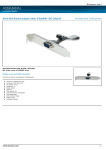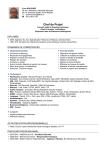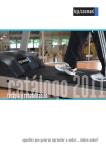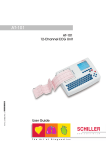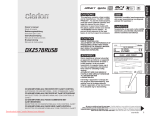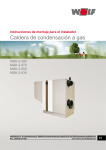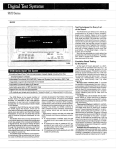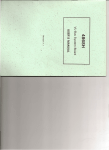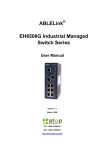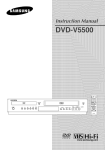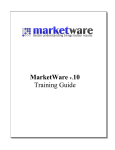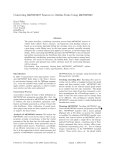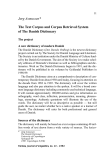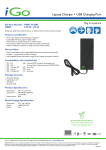Download MarketWire
Transcript
Fax: 574-4293 574-4222 MarketWare Computer Systems MarketWire Volume 2, No. 2 May, 1991 News From MarketWare Computer Systems Everex Shipping 486/20SX Systems By JACK IVERS By the time you read this, Everex should be shipping 486/20SX systems, making them one of the first vendors to do so. Everex has announced both STEP and Tempo 486/20SX machines; the Tempo is scheduled to ship in late April, the STEP in early May. The Tempo system includes a 128K external cache in addition to the 486’s 8K internal cache, and has a maximum RAM capacity of 32Mb. The STEP system has the same memory architecture as other high-end STEP systems 386/33, 486/25, and 486/33 — which means 128K to 256K in external cache and up to 64Mb of DRAM. The Tempo machine comes in small and large chassis options, while the STEP machine is available in small, large, and Tower configurations. The real question is, “What the heck is a 486/20SX, and why do I need one?” The Intel i486SX chip is similar to the i486, except for clock speed, and the lack of a built-in math coprocessor; Everex’s 486SX systems are socketed for Intel’s i487SX coprocessor chip. Price/performance is what really sets the i486SX apart. Everex reports that their 486/20 SX systems offer better performance than STEP 386/33 systems (as fast as they come); yet the price is just slightly more for the 486/20 SX. So the 486/20 SX machines offer a performance level between 386/33 and 486/25 systems, while setting a new standard for price/performance, especially for applications that don’t need the i486’s built-in coprocessor. Another brand-new Everex system is the STEP 386/20SX, now shipping. While benchmarks aren’t yet available, I’d have to guess that the new STEP system will be one of the fastest 386SX systems in production; it has a 64Kb cache, and uses Everex’s AMMA memory management scheme — the same scheme that puts STEP 386 and 486 systems well ahead of most competitors. Like other new-generation Everex systems, the STEP 386/20SX allows you to mix and match SIMM modules to achieve virtually any desired RAM capacity, up to 16Mb total. The new-generation motherboard includes an integrated IDE host adapter, as well as two serial and one parallel ports, increasing available expansion slots. A new-generation feature available in the 386/20SX is Everex’s Advanced BIOS, including the Programmable Drive Table (PDT). If you’ve ever been frustrated when your PC’s BIOS didn’t support the head/cylinder configuration of your new hard drive, you’ll appreciate PDT: it allows you to program your own drive configuration. Also provided in the new BIOS is boot-time password protection: no password, no access to the system. (For the forgetful among us, this feature is thankfully optional.) As a final feature, the new BIOS provides a friendly, menu-driven SETUP process. Everex has announced another 386/ 20SX system, this time an upgrade to their popular Tempo LX laptop. The Tempo LX is now available in three configurations: 386/16SX with 20Mb hard drive; 386/20SX with 40Mb Continued on page 2 Everex... In Other News . . . . By JACK IVERS Novell has revamped their entire product offering. NetWare 2.2 replaces ELS I, ELS II, Advanced, and SFT NetWare; while NetWare 3.11 replaces NetWare 386. Both products are now stratified by number of concurrent users, rather than by features. NetWare 2.2 comes in 5, 10, 50, and 100 user versions; NetWare 3.11 comes in 20, 100, and 250 user versions. NetWare 2.2 now includes all of the features of Advanced and SFT NetWare, including SCSI drive support and disk mirroring. May, 1991 What's Inside The new pricing puts the NetWare 2.2 50 user product at the same price as the NetWare 3.11 20 user product; for networks of more than 10 but less than 20 users, this makes NetWare 3.11 quite attractive. The net effect here at MarketWare has been lots more NetWare 386/3.11 moving out the door. Great Plains Software will ship version 6 of Great Plains Accounting on May Continued on page 2 In Other News... 1 On The Bench ............... 2 Network Corner ............. 3 HomeFront .................... 4 Clone Fever ................... 5 Worksheets .................. 5 Getting it Right .............. 7 Coach's Corner .............. 7 Windows 3.0 ................. 9 TextWare ...................... 11 Office Automation ......... 13 Jaws IV ......................... 14 Real Estate ................... 16 10BASE-T ..................... 18 MarketWire MarketWare Computer Systems Continued from page 1 drive; and 386/20SX with 60Mb drive. The Tempo LX is a hot product; see hands-on feedback in the “On The Bench” section. Everex is now bundling Microsoft Windows 3.0, along with an Everex twobutton serial mouse, with every STEP and Tempo 386SX and above they ship. The mouse is built for Everex by Logitech, and while not as fancy as Logitech’s new MouseMan, it’s definitely good enough to use, with a rounded ergonomic shape; unlike the junk some manufacturers bundle with their machines. All in all, a welcome addition, worth at least $150 to the buyer. Figure this into your price/ performance calculation when shopping STEP and Tempo systems versus other vendors. 574-4222 and drum consumables are readily available. All in all, a good buy; the only printer that comes close in price is NEC’s SilentWriter Model 90, and the LaserScript LX has more features Everex’s lineup of graphics cards is growing stronger by the minute. In the last issue of MarketWire, we introduced Everex’s high-end Viewpoint VRAM and DRAM cards. Now Everex has introduced new low-end and midrange cards. The Viewpoint Standard, Everex’s low-end offering, is a 16-bit, 256K card with 800x600 capabilities. Price: under $75. Next up is the Viewpoint NI, available in 256K and 512K models. Unlike most other midrange cards, the NI supports 1024x768 non-interlaced resolution; hence the NI name. The 512K card sells for under $165. Fax: 574-4293 By JACK IVERS Everex’s Tempo LX 386SX notebook system is a neat machine. We’ve had a demo unit for the last 60 days, and it hasn’t spent much time here at the office. The Tempo LX received rave reviews in several recent magazine reviews, including PC Computing, and we agree. The backlit LCD screen is a crisp, black black on white white. They keyboard has the same clean click and feel as Everex’s new STEP and Tempo keyboards. We haven’t had the nerve to try PC Computing’s torture test — they dropped the LX off a table onto the floor, and it survived — but we believe it. We received our first Everex STEP Tower configuration recently, a 486/25 destined for the desk of Tommy Sedler at Home City Ice Co. The Tower chassis is the best we’ve seen, with You might be surprised to note that the excellent component quality throughnew 486/20SX is available in a small out, a sturdy metal handle for moving footprint version. This is a trend at the system, and a non-tip base. The Everex: wherever possible, new Tower configuration includes a 250W motherboards are “baby” configupower supply, with four rations that will fit into a smallfront-access half-height footprint chassis. Everex’s STEP drive bays, and two full"...they dropped the LX off a table 386/33 motherboard is a “baby” height internal drive bays. onto the floor, and it survived..." configuration, and soon all of the If you need more room, STEP and Tempo 386SX move up to the Megacube, motherboards will be “babies.” which is now shipping. Lots of power in a small package. We’ve got multiple NetWorth Series Continued from page 1 Everex’s Abaton division is breaking 4000 chassis-based 10BASE-T hubs new ground in the PostScript laser on the bench now, along with 10th. The new version includes printer arena with their LaserScript NetWorth’s EtherManager network hundreds of new features, including a LX. With a list price of $1,999, this super-powerful financial report writer in management system. For 30+ node printer offers significant upgrades to networks, this is the way to go. A the General Ledger module, as well as the original LaserScript, which listed for customizable menus and macro capabili- single chassis can support up to 120 $2,999. The LX is based around a nodes, with no ports lost to hub ties in all modules. 25MHz RISC processor for faster interconnection (a drawback of PostScript processing. It supports NetWorth is now shipping a new Smart standalone hubs). The biggest benefit, three interfaces — parallel, serial, and though, is the availability of the 10BASE-T Module for their Series 4000 AppleTalk — all “hot” simultaneously, EtherManager network management 10BASE-T hubs. The new module so that Mac and PC users can share the provides 12 10BASE-T ports, and software. While providing network printer without switching the front management at the physical and data network management capabilities, in a panel. In addition to PostScript, the LX link layers like other network managesingle module, saving both dollars and can emulate an HP Series II, and ment products, EtherManager also chassis slots. See below for more provides automatic emulation sensing: provides node-level network managefeedback on the Series 4000. if you talk HP to it, it switches into HP ment. Because its data collection emulation, and vice versa for facilities run as VAP or NLM on a PostScript. The LX is based around the network server, and because special same 6ppm TEC engine used by Epson, graphics are not required, EtherMicrotek, and many others, so toner Manager does not require a dedicated On the Bench MarketWire 2 May, 1991 Fax: 574-4293 574-4222 Network Corner The State of the 10BASE-T Marketplace By JACK IVERS 10BASE-T Ethernet is the IEEE standard for running an Ethernet network over standard telephone-grade cable. 10BASE-T Ethernet offers the full 10Mbps bandwidth of Ethernet, with the advantages of a star topology and inexpensive, easy-to-manage cabling. 10BASE-T Ethernet networks have two primary components: network cards, and 10BASE-T hubs or concentrators, which act as the central connecting point in the star topology. 10BASE-T Ethernet started out expensive: on a typical 15-node network, you’d pay $4,500 more to go with 10BASE-T Ethernet than with standard thin coax Ethernet. Even at this price, 10BASE-T Ethernet was attractive; simplified cabling and a star topology can save lots of dollars over time. Today, the 10BASE-T Ethernet market is a much different, much improved place — at least for you and I. (I wouldn’t want to be a 10BASE-T manufacturer at the moment.) The market is evolving rapidly in two separate directions: low-end and highend. On the low end, prices are falling rapidly, both for network cards and for hubs. Today, you’d pay only $2,400 more for 10BASE-T Ethernet on a typical 15-node network. At this price, it isn’t difficult to justify 10BASE-T versus coax Ethernet. At the high-end, dozens of vendors are offering chassis-based 10BASE-T wiring centers with network management capabilities. Chassis-based wiring centers have multiple card slots, much like the expansion slots in your PC. Each slot can take a variety of modules. For example, NetWorth’s Series 4000 has the following modules available or planned: 12-port 10BASE-T Ethernet module with 12 RJ45 jacks 12-port 10BASE-T Smart Ethernet module with 12 RJ45 jacks, as well as network management Network management module Fiber hub module Other vendors, such as Synoptics, Chipcom, and Cabletron offer an even wider variety of plug-in modules, albeit at a much higher cost. The multi-slot architecture provides a nice degree of flexibility, and allows a large number of nodes to coexist at a single Ethernet level without repeat counts, something not possible when you interconnect standalone hubs. Network management is the other big benefit of high-end products. Imagine a network of 100+ nodes. Now picture a flaky network problem — certain users get knocked off the network at certain times, and you can’t quite pin down what’s happening. This is the exact scenario that network management is designed to help with. With a network management like NetWorth’s EtherManager, you can see exactly what is happening, and fix the problem. High-end products are predictably more expensive, but the payback is quick. On a network of 50 or more stations, a high-end chassis-based system with network management will normally pay for itself in under a year, based on reduced network downtime and saved man-hours. NetWorth’s Series 4000 is a favorite of ours, since it provides highend functionality at a price not far above the low-end. What next? More of the same: continuing price reductions on the low-end, and increasingly powerful features on the high end. Whatever the segment of the market your company fits into, the news is good. MarketWare Computer Systems PC (as HP’s Open View Manager does), and can run from any station on the network, including monochrome systems. Other interesting EtherManager capabilities: EtherManager allows you to define alarm thresholds relating to traffic volumes, link failures, even disk space shortages. In the event of an alarm, EtherManager can display warning messages, or even issue a page by dialing the network administrator’s pager using a server-attached modem. EtherManager can manage all attached Novell LANs, including non-10BASE-T LANs, such as the StarLAN network in financial aid. EtherManager maintains a complete PC configuration inventory on every managed network. Information tracked includes processor, base memory, extended/expanded memory, LAN driver and shell version and configuration information, attached hard drives and I/O ports, etc. The network administrator can easily produce an inventory of all networked PCs and their configurations. All considered, a LAN administrator’s dream. We’ve got about 60 Everex 10BASE-T network cards stacked up against one wall of our build-up area in preparation for a large installation. So far, so good: the cards work as advertised. With recent price reductions, we’re selling more and more Everex cards with 10BASE-T networks. Need a workhorse impact printer? As MarketWare tackles more and more downsizing projects, where mini and Continued on page 5 On The Bench... Continued from page 3 mainframe users are porting applica- May, 1991 3 MarketWire MarketWare Computer Systems 574-4222 Fax: 574-4293 HomeFront News at MarketWare MarketWare is now an authorized dealer for Great Plains Software, the makers of the Great Plains Accounting system. We evaluated a number of topquality accounting systems besides Great Plains: Macola, MAS/90, Realworld, Solomon, Platinum, etc. All of the above are fine accounting systems, so the choice was difficult. Great Plains won us over on four counts: features, customer support, product delivery structure, and company stability. Feature-wise, while no package is always the best for all customers, Great Plains offers a very strong set of features, especially with version 6. Great Plains’ customer support is, without question, the best of any of the majors; the authors of In Search of Excellence recently used Great Plains as a customer support case study. Great Plains’ product delivery structure is ideal: resellers like MarketWare sell the software and the hardware platform it runs on, while Qualified Installers (QIs) install and support the product. QIs are typically CPA firms; they know accounting in general, and Great Plains specifically. QIs can give you advice on structuring your chart of accounts, for example, something MarketWare would be afraid to touch. This clear-cut differentiation between reseller and accounting expert appears to us to be the ideal way to deliver an accounting package. Finally, while other accounting system developers are laying off people, or even filing for bankruptcy, Great Plains is still showing healthy growth. Hence our decision. If your company is considering a new accounting system, let us know. We’ll survey your needs to determine if Great Plains is a good fit; if so, we’ll set up a demo for you to see the product. MarketWire MarketWare is pleased to welcome Alan Monaghan to MarketWare’s technical staff. Alan should be getting his Novell Certified NetWare Engineer (CNE) rating around the time that you read this. In addition to his considerable NetWare expertise, Alan has extremely good general PC and communications knowledge. MarketWare will begin offering MarketWare’s NetWare System Manager course in May; call us for dates. This course is designed to offer content comparable to Novell’s System Manager course, with less of a “Sell Red” attitude. For example, the MarketWare course will cover products such as Saber Menu, Printer Assist, and XtreeNet that aren’t Novell products, yet are a key part of the NetWare operating environment. The new classes will be held in MarketWare’s newly-equipped Education Center (our seminar room with PCs on every desk) at our Harrison Avenue offices. MarketWare will also be offering a newformat networking seminar on a monthly basis in the same facility. The new MarketWare Networking Seminar will be a single-day, all-day affair, with the morning session covering LAN basics, components, and considerations, and the afternoon covering downsizing, connectivity, and wide area networking. We will hold this seminar on the third Tuesday of every month, starting in May. Exact dates: 5/21, 6/18, 7/16, 8/20, 9/17. The fee: $75 per attendee. Call to reserve a spot. MarketWare has launched TSP, our Total Support Plan for networked and standalone PC users. TSP provides comprehensive installation, training, 4 and technical support services for your complete computer platform — software, hardware, and network. Basically, TSP is an alternative to billing by the hour. You pay us a given amount (upfront or monthly), and we provide as much help as you need. We find this approach better than hourly billing for both parties: you don’t have to worry about being nickle-and-dimed to death with hourly charges, and we don’t have to hassle with hourly billings. TSP is generally billed in two chunks: an initial fee for product installation and training, and an ongoing monthly fee for product support. We figure TSP pricing using a product size/complexity matrix that we developed under Quattro Pro. Network support pricing, for example, takes into account the network operating system, the number of attached nodes, and the degree of complexity of the network. We offer both TeleSupport and OnSite TSP plans. If you elect to go with TeleSupport and need on-site assistance, we bill at a 25% discount off our normal hourly rates. We hope the majority of our customers will come on board with one variety of TSP or another. NOTICE If you're not on our mailing list and want to continue to receive the MarketWire newsletter, call us. We'll be happy to send you future editions free of charge. May, 1991 Fax: 574-4293 tions to LANs, we need heavy-duty, reliable printers. In a recent downsizing installation, we tried Output Technology Corporation’s 850XL, and were quite pleased with the results. The 850XL is a tri-matrix printer: it uses three printheads, and prints three lines at once. With a draft throughput of 850cps, the 850XL is significantly faster than Okidata’s 393 Plus, another favorite. The 850XL is built tough, with a degree of sturdiness you’d normally see only on minicomputer printers. OTC also offers even faster line printers, with rated speeds of 400lpm and 600lpm; and a 16ppm laser printer that prints on standard fanfold computer paper. 574-4222 MarketWare Computer Systems mend them for Novell server use; SCSI’s a much better solution. — a dozen or more MMG 386DX systems. We just installed an OkiLaser 840 with second drive mechanism as our production PostScript laser printer. We’re quite pleased. The type on the OkiLaser is slightly more fine (less bold) than that of the Everex LaserScript that the OkiLaser replaced; overall, I like the fine OkiLaser output a little better. As far as PostScript performance goes, the two printers are pretty close, with the edge going to the Everex with its RISC processor; the OkiLaser’s 8ppm engine more than makes up the difference, however, once the initial PostScript processing is completed. The dual bins They ran into one slight problem: the MMG machines didn’t quite work. Whatever clone motherboard manufacturer MMG happened to be using at that point in time (they’ve probably been through three different motherboards since) hadn’t done their homework on application compatibility. The motherboard builder probably didn’t have an extensive compatibility lab like Everex does, and hadn’t tested the nastier, less common applications. As a result, the company’s mainframe terminal emulation software didn’t quite work right. Low-end hard drives are At the same time, the end "At the same time, the end users revolted. undergoing a revolution. users revolted. They didn’t Not long ago, the like the cheap look and feel They didn’t like the cheap look and feel of standard standalone PC of the clones. One purchase the clones. One purchase requisition configuration include a requisition specifically Seagate ST251 40Mb specifically stated, “We don’t want a clone stated, “We don’t want a MFM hard drive, a halfclone system.” system.” height 5.25" form factor drive with a 28ms average Now the company is moving seek time. The next step up was to the away from cheap clones, Seagate ST4096, a full-height 5.25" and coming back to the middle ground: on the OkiLaser are a real plus. The drive. It was difficult to find a drive high-quality compatible systems. only problem we’ve had with OkiLasers above 80Mb but less than 160Mb. Among such systems, Everex is a in the field — toner flaking on certain Today, we’re shipping almost exclustrong contender. Everex’s compatibilheavy letterhead stocks — appears to sively 3.5" form factor IDE drives in ity lab earns its keep time and again; the be a warm-up issue: once the printer is our standalone machines. Here are mainframe terminal emulator works warm, the toner sticks. Recommended, some drives we have used and like: perfectly, as does everything else especially when you consider the they’ve tried. Everex’s commitment to OkiLaser’s sub-$2,200 price. Seagate 157A: 44Mb, 28ms, quality pays off as well; you can put an 3.5" full-height Everex system on the desk of a former Compaq owner, and not get look-and Maxtor 7080A: 81Mb, 17ms, feel gripes. Speed also helps: Everex 3.5" half-height systems consistently outperform their Quantum Prodrive 80: 84Mb, Compaq counterparts. Finally, while 19ms, 3.5" full-height By JACK IVERS you can’t get two Everexs for the price One of MarketWare’s LAN customers Seagate 1102A: 89Mb, 19ms, of one Compaq, you probably can get is in the throes of picking a corporate 3.5" full-height three for the price of two. PC standard. For years, this company Was this company wrong in its bout Seagate 1144A: 124Mb, 19ms, had largely standardized on Compaq. with Clone Fever? Probably not. 3.5" full-height Dozens of local resellers — Sometimes you have to see for yourself Maxtor LXT200A: 201Mb, MarketWare included — tried to — especially when you get twenty 15ms, 3.5" full-height convince them that they were paying different stories from twenty different too much for the Compaq name. About resellers. But we agree with their final Today’s IDE drives are faster, smaller, nine months ago, they caught Clone analysis: for most companies and most and use less power. More importantly, Fever, and reversed directions entirely. applications, high-quality compatible they offer the increased capacity — They realized they could get at least systems are the best corporate PC often 80Mb to 200Mb — that today’s two low-end clones for the price of one standard. standalone user needs. Recommended Compaq system. They bought heavily for workstation use. We don’t recom5 MarketWire May, 1991 Clone Fever MarketWare Computer Systems Worksheets on a Disk By TOM IVERS Have you ever wondered how to use Lotus 1-2-3? Or Quattro Pro? I mean really use these versatile spreadsheets with all their macros and functions? I confess here and now that I’ve never made it past simple ledger sheets and P&L statements — certainly not into complex “what if”s or consolidated reports or any of that stuff. Truth be known, I’d prefer not to know what’s going to happen a year from now — depressing enough today. But Jack found me Worksheets-On-ADisk, put together by Cincinnatian, Frank Doerger, and now I’m fascinated. There are 40 worksheets, WK1 files, on this disk, and they do all sorts of things. It’s as if somebody had started a little Lotus workshop and had hammered out 40 simple, useful tools, while showing how each was made in hopes that I’ll catch on and make some of my own. Delightful. Many I can use right now, without alteration. For example: ABSENTA and ABSENTB. These worksheets track employees’ absences from work. The dates, the hours, and the reasons. The difference between the two worksheets is that ABSENTB allows you to sum total time off for a given employee. This is a godsend for my business because periodically, Goofy goes AWOL and, a couple of months later, my neighbor comes by with an armful of black puppies. If I track Goofy carefully, I think I can build a “what if Goofy was locked in the garage?” worksheet that will save both the embarrassment, and the expenses, of having to raise dozens of gigantic Gordon Setter/Golden Retriever, hybrid vigored, crotch sniffing, car chasing, mole hunting, bird harassers. The disk pays for itself right there. 574-4222 and computes the number of days the invoices have remained unpaid. Now I can track how many days it takes Colonel Leatherbury from down the road, sometimes known as Creekwalker to his nefarious friends, to replenish, or return the favor some other way, for the firewood he swiped from the woodshed this winter when I wasn’t looking. One day present him, down at Country Stuffins, over a worn out waffle and a bottle of Bud, a complete reckoning. That’ll let him know who he’s messing with! ANCASH presents a monthly cash budget, beginning with a balance, adding receipts, subtracting disbursements, and leaving an ending balance to begin the next month. Neat. Now all I need is a beginning balance. AUTO contains several file retrieve macros, so that files in subdirectories can be brought up efficiently. For example, I might have a directory named DOGABS, within which are individual absence records for Goofy, Tarnation, and Zeke. I’d hit “A” for macro A, and Lotus would let me select which dog I wanted to pick on. Or another directory called BROABU, wherein files containing ideas for written abuses of my three brothers, Jack, Bob, and Bill, might be stored — I’d hit “B” and there’d be three files full of abusive remarks, ready for instant inspiration. AWARDA & AWARDB list employees’ names and hire dates and calculates the number of years each employee has been with the company with AWARDB adding birth dates and calculating ages. No use to me. I don’t want to know how long I’ve been trying to squeeze a living out of this computer, nor do I want to know how old Edie is. Some things are better left in obscurity. BANKREC reconciles a bank statement to a checkbook balance. There Fax: 574-4293 should be a BANKRECB, to account for “float.” BONUSA and BONUSB calculate employee bonuses based on a percent of annual earnings, with a minimum and maximum bonus, BONUSB calculating sales rep bonuses based on percentages of yearly sales for each rep. Creekwalker’s bonus will be calculated in tons of horse manure hauled out to the pastures and spread. His AGINREC will be considered at the end of the year. He might end up owing manure — can’t tell yet. CALENDRA and CALENDRB display a calender of events, with CALENDRB offering simplified date entry and displaying the day of the week for each event. Very important for a writer because there are some days it’s absolutely necessary to arise, shower and shave before noon. Good to know ahead of time, especially if you’re not really sure what day it is, or what year, for that matter. CARLOAN calculates monthly payments for car loans. Discouraging. Not recommended. CHECKS sums check amounts by expense categories, including food, housing, auto, repairs, fun, health, etc. I guess .44 magnum shells go under fun since any food they hit would have to be peeled off nearby trees and shaken out of bushes. COUNT calculates the number of employees with various fringe benefits and computes the percentage participation. Let’s see, I’ve got one into firewood, three on automobile tire watering — make that two, Tarnation operates differently than the other two. I’m on early retirement and Edie gets all the food she can cook. CUSTMERA and CUSTMERB store and print customer information, with CUSTMERB laying out the information horizontally. DISBURSE presents a monthly cash budget and calculates total AGINGREC lists outstanding invoices MarketWire 6 May, 1991 Fax: 574-4293 574-4222 disbursements by the date you plan to pay them. Coach’s Corner FIND finds information in a large database of part numbers. GRADING tracks the number of problems or questions students missed on tests. INVOICE calculates and prints an invoice. INVENTORY values an inventory. LABEL3 prints three different size mailing labels. LIFEINS calculates employees’ life insurance amounts and monthly premiums. LIST prints mailing labels from an address book. LOANA and LOANB present a monthly loan payment schedule, with LOANB indicating those with payments due on the last day of every month. MORTGAGEA and MORTGAGEB calculate monthly mortgage payments, with MORTGAGEB calculating under a variety of possibilities. PAYABLE tracks invoices to be paid. PHONESA and PHONESB quickly find a telephone number in a directory, but PHONEB uses macros to sort names alphabetically and to print. PRICING calculates a retail price using the wholesale cost and a markup percent. PROJECT displays the start and end date of separate tasks and presents a graphic representation of the schedule. RAISESA calculates the effect of raises for hourly employees and RAISESB calculates the effects of raises for salaried. The calculated effect of a raise for Colonel Leatherbury showed up in ABSENCEA under “coon hunting.” SALES presents monthly sales by product. TRAVELA prints a blank expense account form and TRAVELB fills it Continued on page 8 May, 1991 MarketWare Computer Systems May 1991 By BOB IVERS Here are some of the questions I was asked since the last newsletter. Remember, if you have a question or have solved a strange problem on your computer, write me and perhaps we'll include your problem in the next issue. Q: When I turn on my machine, I get a message “Bad or missing COMMAND.COM. A: DOS needs three files in order to boot itself. Two files, usually named IO.SYS and MSDOS.SYS are hidden and must be located at a specific location on the drive. The third file, COMMAND.COM, is a normal DOS file that must reside in the root directory of drive C:. The problem with COMMAND.COM, unlike the others, is that it can be moved, renamed, deleted, or replaced since it appears much like a normal DOS file. All three of these files are related. With different versions of DOS, you get different versions of all three files. You cannot mix different versions of these files and have them work reliably together. Because COMMAND.COM is so easily overwritten by another version of itself by just copying all files from drive A:, or by accidently deleting all files in the root directory, we get frequent calls on how to solve this problem. We always set up drive C: with a C:\DOS directory which contains a the version of DOS we used to format the hard drive. In that directory resides a copy of COMMAND.COM. Simply copy that file to C:\ (COPY C:\DOS\COMMAND.COM C:\) and reboot. If that doesn’t work, try booting from the system diskette that came with your computer - if there is no physical problem with your drive, you should be able to change to drive C: and copy COMMAND.COM from the diskette. 7 Q: After I Login to the network, my machine will hang after I exit a program and give me the message “Invalid COMMAND.COM - Machine Halted” A: This problem is similar to the previous one. In this case, all worked fine until the user logged into the network. Novell networks have the ability to determine which version of DOS, such as V3.30 or V4.00, a PC has booted up with. Many times, in an effort to standardize the version of DOS for all users on the network, a COMSPEC setting is used to identify a new, common location of COMMAND.COM. Then, each time DOS requires something within the program COMMAND.COM, it looks in the new location for COMMAND.COM rather than the old. This technique will speed up a computer whose COMMAND.COM is located on a floppy boot disk, improve virus protection and enforce DOS version standards network wide. The problem is, not all DOS versions are the same. DOS V3.30, originally written by Microsoft, may have been slightly altered by the computer vendor. Compaq DOS V4.01 is different than IBM’s, but they’re both the same version. If you boot your machine using Compaq DOS, then log into the network which sets a COMSPEC setting to an Everex version of DOS on drive F:, your machine will halt with “INVALID COMMAND.COM SYSTEM HALTED” after you exit your next program. The fixes to this problem are: 1) Don’t’ set a COMSPEC setting when logging into the network or 2) Set a COMSPEC setting based not on the DOS version, but on the node address of the system or 3) While we don’t recommend this, it is possible to use Continued on page 17 Coach's Corner MarketWire MarketWare Computer Systems in. There should be a TRAVPAD, but Frank forgot. YRTODATE performs year-to-date comparisons for a given number of months. That’s 40 worksheets, but Frank didn’t stop there. He’s got 21 more worksheets stuffed onto this disk that he calls “Tips, Hints, and Helps” worksheets. These demonstrate how to use a variety of functions and commands available in Lotus 1-2-3. My favorite was RANDOM, demonstrating how to produce random numbers within a specified range. You have no idea how much this helped on the tax returns. Working alone, I kept coming up with numbers like $4444, or $2468, or, subversively, $1357. With RANDOM operating, I got numbers like $3165 — much more impressive! I thought of using ZEROOUT, but I’m afraid that wouldn’t have sold well at the IRS. The manual for Worksheets-On-A-Disk is well written, clear, and instructive beyond the call of duty. It is easy to see that Frank is a good teacher and that he knows his stuff. W.O.A.D. requires an IBM compatible with at least 256K, DOS 2.0 or higher, and Lotus 1-2-3 2.0 or higher. List price is $59.95, but we can get it for you for $24.95; Frank is doing some test marketing in Cincinnati. Also available are three 1-2-3 SeminarsOn-A-Disk for 1-2-3 fundamentals, macros, and data base management as well as disks of 100 macros and templates for 1-2-3 or 280 macros for WordPerfect. One for $59.95, two for $99.95, three for $129.95. Frank’s got a little marketing savvy, too. If you use Lotus 1-2-3, you can’t miss on this offer. Recommended. Happiness Is: Getting It Right MarketWire 574-4222 The First Time By TOM IVERS Red Adair, when asked recently about his two Mercedes and big Cigarette boat, said, “If you think hiring an expert is expensive, just wait till you hire an amateur.” While no one at MarketWare drives a Mercedes, and the boats are all Hobie Cats, we still think Mr. Adair’s thought is worth exploring in the context of computers and networking. Each month we lose a dozen or so sales, some of them big ones, to companies which bid under us. Each month, too, we get called out to an equal number of sites to repair or replace competitor’s systems which have failed to deliver what was originally promised or expected. These are invariably unhappy experiences for both ourselves and the client, because when inadequate equipment is installed by folks with limited expertise, solutions to the resulting problems are expensive. The client greets us with a snarlingly healthy disrespect for computer resellers. No fun. Fax: 574-4293 technology where peripherals and upgrades are equally expensive, is bad economics. That’s why we sell Everex. Powerful, reliable machines in a medium price range. When the day comes that Everex is no longer reliable or competitive, we’ll be ready with a new platform — we’re continuously exploring the territory. Further, we work on a low margin, one that is below most of the rest of the industry, in order to ensure that we stay competitive. In fact, we recently went shopping for a box that would beat Everex’s prices by $500 to $1,000, in order to compete with some of the low end boxes that are deluging the local market. We found several. That was the easy part. Next we had to look at reliability, both of the box and of the supplier. Some of the companies were switching around from one motherboard to another, depending on available supplies. This is no good for us, because we want to stock replacement motherboards and other key components for everything we sell, and we want to know all the quirks of the machines we’re putting out in the field. It’s one thing to sell individual computers to individual users, another to sell and support dozens of machines at a single site where, when the network crashes, big money is involved in lost client manhours. You just can’t take unnecessary chances by basing decisions strictly on price. The purchasing agent at most companies has two principal goals in mind as he buys computers and network installations: a complete solution and a good price. We understand that. We have precisely the same goals in mind when we make our own purchases. But the perspective Then we had to we bring to the consider the cost table may be more of bringing on "If you think hiring an complex than that another line of of some potential computers. expert is expensive, just clients when it Initially, it’s a wait 'till you hire an comes to our area matter of bringing of expertise. amateur." -Red Adair in a parts invenHere’s the way tory for the new we think: line — typically about $30,000. At the same time, the There is no question that price is a entire organization has to be brought primary consideration in the purchase up to date on the new models, the of computing equipment. In fact, we pricing database has to be updated, the tend to feel that buying Compaq or IBM techs have to learn the equipment, the machines at a premium price, and salesmen the features and values to the locking yourself into proprietary customer. 8 May, 1991 Fax: 574-4293 574-4222 our clients. We want to. We’d love to Some of the companies we talked to had have machines that allow us to make a great prices, but no supporting services reasonable profit at extremely competi— they wanted us to explore the tive prices. Meanwhile, though, Everex territory, making our clients the guinea prices continue to drop, right along pigs, our staff the goats. Others had no with the rest of the industry. And we spare parts because their lines were know our Everex boxes like we know the constantly in flux backs of our — sell one box hands. today, another "They wanted us to exwhen that special And that brings plore the territory, making purchase runs us back to Red out — all under Adair’s stateour clients the guinea the same brand ment. We are pigs, our staff the goats..." name. Nothing experts in Everex to talk about but equipment. We price, because no know how to one knows what’s going to be in the build networks with Everex equipment box until it arrives, and no one knows that fly and keep flying. We can safely whether it’s going to keep flying until say that we are as competent at our it’s out there either making friends or jobs as any company that installs enemies for the company. Too big a networks in Cincinnati, and better than chance to take. most. The relationship with the supplier is another key ingredient in this decisionmaking process. At this point in time, MarketWare is one of Everex’ biggest dealers. Everex likes us; they take care of us. In an emergency, we have parts in the air almost as soon as we get off the phone — and they answer our calls! Everex computers are American made, so we’re aware of any changes in configurations immediately, and we’re close, in relative terms, to the manufacturing plant — we get the new stuff immediately. All of the companies we contacted about low priced equipment were buying machines from Korea, Taiwan, and other far-east countries under short-term, large purchase contracts. None of them knew MarketWare from Adam. None of them had any reason to give us special treatment, keep us out of trouble, and none of them had any incentive to avoid selling us the proven duds and leftovers from their bad-buy inventory. If you don’t know it yet, take it from us, there’s a lot of garbage out there. We know, because we often have to try to integrate these machines into larger networks — no fun at all! So, right now, we’re still looking for cheap machines that we dare to sell to May, 1991 We’re a small company with key, welltrained people. We’re not a chain, so we’re not stuck with a bureaucracy that prevents us from going out of our way to deliver the very best in equipment and service, no matter the cost. We’re building our business slowly, a step at a time, planting seeds of confidence in our client base — fully 75% of our sales are repeat sales to existing customers. We have to be careful not to grow too fast, not to expand our customer base beyond our capacity to serve it with alacrity and efficiency. MarketWare Computer Systems not be familiar with the environment or have an inkling of a solution to the problem at hand. We know you can get networks slapped together from a hundred different sources. We know there a dozens of ways to save on up-front networking costs. We know, too, that you can easily get yourself into big trouble very quickly, trouble that will cost you far more money than you originally save by going to the wrong source or by trying to hack together a do-it-yourself system. We’re doing our best to help you avoid the big mistakes. We put on regular seminars which are educational, not sales pitches, so that when you decide to network, you’ll be armed with knowledge that will keep you out of trouble. We offer our own expertise and take full responsibility for every system we put in. We supply reliable equipment with rock-solid warrantees. We go out of our way to help you solve problems caused by other suppliers. We want you to know exactly what it means to be dealing with people who specialize and who know their stuff! And so, we can absolutely guarantee you that we’ll save you money over the long term. It’s our business to do just that. Of course, talk is cheap. There’s no reason for you to believe that what we’re saying on these Now, we "We’re not a chain, so we’re not pages is true. know you In that can buy stuck with a bureaucracy that regard, we’ve cheaper prevents us from going out of assembled boxes. some Mail order our way to deliver the very best references for companies in equipment and service, no you — abound matter the cost. " people who with will tell you cheap, and about our sometimes abilities. The list is available upon your excellent, machines. But even the very request. These are busy folks, but best get themselves into a tangle, they’re willing to briefly share their especially when they’re part of a network. Then you have to bring in the experiences with us. Don’t pester them, but give them a call for a MarketWare “experts” that came with the machine’s review. warranty. “Experts” that may or may not respond quickly, and may or may 9 MarketWire MarketWare Computer Systems Project WIN STORM, and More By TOM IVERS A few months ago I promised, with my teeth set under heavy pressure, that I would, just for you, get a Windows 3 environment up and running. I’ve done that, with my new CUI 386-33 box (MarketWare’s low-end clone) towering three feet high on my desk, its guts revealed — see “Jaws IV,” the saga of the setup. I’ve got two non-windows programs running right now, in separate windows, with Windows running under DR DOS and its own memory management software. So far, no glitches, and I have only myself to thank for that. Myself and DR DOS. Now I can chuckle as I pass Bob’s office late at night and hear him yelp and howl as Windows aborts in the middle of a session under Microsoft DOS. Brother Bob, the Windows Phreak, the Pagemaker True Believer, our DOS Guru and NetWare Engineer. I blythefully run PowerPoint, Paradox, Excel, dBASE, Corel Draw, WordPerfect, and TextWare, two or three at a time, and never hit a bump. Windows treats Bob just like the race horses used to treat my brother-in-law, Pat. They’d step on him, bite him, or kick him every day, sometimes several times in a day. At that time, Pat was the horse expert like Bob is our Windows expert now. Hold on, I’ve got to take a break: I’m laughing so hard I’m tearing up and can’t see the screen. It was pure serendipity that the horses liked me, and it is the same, as far as I can tell, that DR DOS and Windows 3 get along so well. Good luck is so much more fun than hard work! Here we had a pair of SCSI 200 meggers, and I wanted big partitions (really, 4 100 meggers would have done, but what I got was a pair of 200Mb partitions) and Bob was so afraid that DOS 3.3’s COMMAND.COM, perverted by some disk manager software, would pollute MarketWire 574-4222 my machine, that he wanted to use DOS 4.01. But DOS 4.01 is such a memory hog, and Ventura is too, that those programs were, for me, incompatible. The solution was DR DOS, because it is more than DOS 4.01 and takes up half the RAM. Less RAM than 3.3 as a matter of fact. Fax: 574-4293 The hall is littered with stuff Bob has thrown at me, and I’m to the point of collapse -- my voice sounds like a little girl’s and I’m sobbing with glee. Haven’t had so much fun since the late sixties and the introduction of Maui Wowee on the mainland. Editor’s Note: DOS 5.0 is nearly here So the Windows War that I had — we hear rumors of a summer release expected went date. Once it’s something like Desert available (and Storm — the Mother debugged . . .), DOS 5 "So the Windows of all Walkovers. should offer the Basically, I plugged it advantages of DR DOS War that I had in and it worked. without the FUD (fear, expected went Same CONFIG.SYS uncertainty, and doubt something like and AUTOEXEC.BAT — IBM’s three rules of files as in the old selling) factor. Desert Storm — machine, except that - Jack Ivers the Mother of all DR DOS has its own form of BOOTCON, so Walkovers." I eliminated the need for a CONFIG.SYS interrupter. On boot, I By TOM IVERS can pop to a Windows setup, a Any word processor worth its salt, as DESQView setup, plain vanilla, or a well as any self-respecting file manager, special QEMM/Ventura setup for will allow the user to take a quick peek running my PS600 card with Ventura at any text file. That’s simply wonderful Publisher. I haven’t, and I won’t — for me because, once I name and save a except for review purposes — move text file, I immediately and forever forget into the Windows version of Ventura. what’s in it, no matter how careful I am That’s like threatening Lady Luck with to make the file name reflect what’s rape. inside. And here I am, writing an article about, When I write a book (I’ve written four), um, oh yeah, TextWare, in one window, I never remember what’s in one chapter with TextWare over there in another, or another until I take a peek, and, even DOC2 of WordPerfect waiting in the then, if I’m trying to discover whether wings, my CUI stuffed to the gills with I’ve already covered a minor point, cards of every shape and description, somewhere in what will eventually be a the scuzzies silently sucking up the megabyte of text before a book is bytes of my automatic timed backup, finished, I have to either reread every with everything I ever wrote, about ten chapter, or use a text string finder like megabytes, available for viewing and ZyIndex, which will show me every file plagiarizing on the other side of an that contains a phrase like “anaerobic <ALT><ESC> command. Believe me, metabolism” or “fast-twitch-highit’s a pleasure akin to driving a 70 foot oxidative.” yacht up the Intercoastal Waterway. TextWare Every ten minutes or so, I go for a Pepsi, or toward the restroom, and, as I pass Bob’s office, I make it a point to say “boo,” or stamp my foot, or clap my hands. You’d be surprised at how many times such an action coincides with another Windows lockup or crash. 10 Extrapolate my stupidity farther, say with 10 to 40 megabytes of text that I’ve never read, perhaps at a megabyte or May, 1991 Fax: 574-4293 two per file, and you’ve got the kind of problem I’d face if I had, say, a law library on disk, or the Bible, or Novell’s manuals, or MarketWare’s price list, or MarketWare’s “things that go wrong and what to do about them” database. Any or all of these on a network server. Even ZyIndex would encounter problems then. Not enough versatility. Enter TextWare, a text indexing and retrieval system by TextWare, Inc. Remember the index cards you used to assemble when you were writing term papers, or theses, in college? Little three-by-fives that had a quoted paragraph, or a single concept written down and later put in order as you began writing? TextWare assembles an online database by way of “cardfiles”, built of conveniently sized pieces of text that are indexed, word for word, gathered together under a document title and eventually grouped under a data base name that constitutes the cardfile. TextWare with Images goes a step farther and allows you to index scanned images as well as scanned text (OCR’d to ASCII). Just as paragraphs add up to chapters and chapters eventually become a book, so do cards glue together to become documents which in turn become a cardfile in TextWare. Actually, the reverse is true. TextWare takes huge pieces of text and indexes them down to hundreds, perhaps thousands of individual bitesize cards, and remembers each card, word for word, so that you can find any single word, or any string, instantly. Let’s assume for a brief moment that Bob was actually functionally literate, that is, he could sit down and write a complete coherent paragraph without becoming dizzy or falling into a coma. What a boon to MarketWare, and to you, our customers. Every time he ran into a problem out in the field and solved it (he seldom fails at these plebeian, blue collar tasks) he could tap in a paragraph describing the event. Later, when you call in with a similar problem, we could have the solution at May, 1991 574-4222 our fingertips and not have to drag Bob away from the cranky, whining, throwmomma-from-the-train (he’s momma) impressions he regales us with on an incessant basis. (He does an excellent Elmer Fudd, too. Next time he’s at your site, plead for a performance.) Unfortunately, Bob is no James Michener. A paragraph, to him, is Hawaii and South Pacific rolled into one. Jack, on the other hand, types something near 200 words per minute. But his 60% error rate slows him somewhat. It is a sheer stroke of luck then that Novell has provided us with their Technical Manual indexed in TextWare. While we slowly gather our own service manual, Novell’s is right at "Unfortunately, Bob is no James Michener. A paragraph, to him, is Hawaii and South Pacific rolled into one. Jack, on the other hand, types something near 200 words per minute. But his 60% error rate slows him somewhat. " our fingertips and, once you describe your problem, we can troubleshoot over the phone — that is, if it’s a Novell problem. Eventually, we intend to skip the middle man and make this database available to you online. Right now, TextWare itself is available to you. Suppose you have hundreds of documents floating around the system, in Word directories, or WordPerfect directories, or even in some old dog’s WordStar directory. You want to assemble the combined knowledge of all your literate brethren in one great resource database so that this information is available, in context, instantly, to anyone on the system. Simple. The first step is to assemble all the documents in a directory named, say, EWEW (Everything We Ever 11 MarketWare Computer Systems Wrote). As these documents come in to the directory, you want the files named with an extension that identifies the word processor used to create them. Word documents would end in .DOC, WordPerfect in .WP, etc. Then you tell TextWare to index those files under a cardfile named EWEW, with individual files, or pages within the files, as separate cards. TextWare will work for a few minutes to a couple of hours, depending on how big the eventual cardfile is going to be. That’s it. Thereafter, any user can run TextWare, load the EWEW cardfile, and go exploring. Every word in those files has been indexed, so the user might find that the words “eat” and “pizza” would have 198 and 33 cards containing them while only 7 cards contained both. You might find that George has 300 cards referring to him while Marsha has 728, but only one card, from Elain’s secret WordPerfect directory, mentions both Marsha and George in close proximity. If 300 cards, from a variety of authors, mentioned George and Marsha, any reasonable office manager would be led to conclude that this pair was an “item.” You can establish the combined vocabulary of your staff instantly. Since TextWare indexes every word, then tells you how many distinct words are included in how many cards in the current cardfile, the WEWE cardfile would show the combined vocabulary as soon as it is loaded. To give you some milestones to shoot for, my fiction vocabulary runs at 12,000 words, while my technical vocabulary approaches 30,000 words. My fictional love-scene vocabulary runs just 18 words, most of them exclamations. Maybe this is why none of my fiction has been published yet. Text retrieval in TextWare is instantaneous on my 386-33. My technical cardfile is indexed by file, which represent individual articles I’ve written, so a search will bring up a hit list of 70 characters each, the title and part of the first line of the articles that MarketWire MarketWare Computer Systems contain the search words or phases. I can select one of these “cards” and the entire article is brought up, with the search words highlighted. TextWare supports Boolean search criteria like “and”, “or”, “andnot” and “whozat.” That last function allows you to look up who the hell this Boule guy was and why his name is cluttering up our language. Meanwhile, one or more images can be tagged and associated with individual cards within a cardfile. For example, information concerning a piece of real estate for sale can be associated with a group of pictures of that property. Cards can be added to or deleted from cardfiles. Cardfiles can be merged. 574-4222 Fax: 574-4293 anywhere within ten words of Comdex or San Diego Seminar, for example. That’ll help. anyone from a phone system huckster to a copier salesman, and they’d have an OA solution too. TextWare allows you to relate cards to one another within the cardfile. In other words, one card can be linked to dozens of others containing further references in the same subject area. This takes some time to set up, but can be very useful when a user is looking for a solution to a technical problem. When you find the information you want, you can print an individual card or an entire document from within TextWare. You can also print every card on the hit list, or just mark a few cards to print from the hit list. Okay. OA is a dead, meaningless term. Pack it away with “Groovy!” and let’s get down to business. . . . Well not exactly. OA is still alive and kicking, but it’s fragmented into its component parts. We now talk about word processing integrating with desktop publishing and archival subsystems. Email, Fax-mail, Voice-mail etc. Spreadsheets interfacing with databases. Network connectivity with minis and mainframes. Local and Wide Area Networks. TextWare remembers the last ten search criteria you’ve used, and allows you to go back through the “stack” to change or combine any of them into a new search command. The program is very liberal with wildcard searches, allowing you to stick an * or a ? at the beginning, end, or in the middle of a word. Whether the “office automation expert” was a recycled programmer, timestudies engineer, or office secretary, the messages eventually merged into a single unified theme, which I will dub the Allendorf Jaded OA Axiom: TextWare usually searches across all Documents in a cardfile. But you can limit your searches to one or several Documents within a Cardfile by selecting from a list of documents contained in that cardfile. For example, “In an age of cheap computer a legal case history cardfile might be resources, it is insane to make made of documents concerning people write things on paper. Taxes, Wills, Divorce, and Rum The more times a given Running, among other exotica, piece of information is reand you might simply be written or re-typed, the "Ask anyone from a phone system interested in dodging taxes, as more insane the practice huckster to a copier salesman, and opposed to federal agents or becomes.” they’d have an OA solution, too." alimony. So you select the So if OA is dead, how come Taxes document, then search for the AJOAA still rings true? “dodge.” Because managers still have a bottom You can edit individual cards from line, and human beings are still the within TextWare. For example, in a costliest part of any business. If you document called Lovelife, you might can eliminate a job, or get the business want to change all references to “Suzi” goal met with less human effort, you’ll By BILL ALLENDORF over to “Mildred” before you take your stay in business. If not, you’ll lose out Now there’s a “Pick of the Crypt” buzzportable computer home. Mildred and the guy who has. Therefore as long as word for you. Remember back in the the kids will be thrilled and Suzi will your human costs remain high, your early Eighties? Everyone was touting never know the difference. OA goals remain the same: “Office Automation” solutions. Every business systems analyst who was You can tell TextWare to “find” partial Get the job done with the least tired of batch COBOL was putting words, as in <find boo*>. TextWare will “Office Automation Specialist” in their amount of redundant human find Boolean, bootable, and “these effort, waste paper, and resume, hoping to get a new job boots are made for walkin’” on the same offering an office with a window view cabling. instantaneous pass. If you say <index> instead of a cubicle. I had a boss for a Provide a consistent userto TextWare, the software will list every short time that was less than a year out word in the cardfile alphabetically. That of the typing pool who called herself an interface so that training way you can see if Suzi turns up becomes simplified. Office Automation Specialist (in fact, I unexpectedly in, say, the Expenses believe she was one of the few real Allow as much application document. TextWare does “proximity” ones I’ve met). Products? Ask IBM, integration as possible, so that searches. You can see if Suzi shows up and they’d say PROFS (period!). Ask Office Automation MarketWire 12 May, 1991 Fax: 574-4293 information can be transferred from one application to another easily and efficiently. Now before everyone grabs a mouse and Windows 3.0, a fax server, and a bunch of 486/25MHz workstations, remember that what turned OA into meaningless drivel in the first place was fanaticism. Just because there’s a way to control the office thermostat from the receptionist’s tube, doesn’t mean it’s a good idea. If your secretarial pool has always worked with a keyboard, they may revolt at the addition of a rodent. If you are working within a budget, you may not want to shell out the bucks for all the memory and processing power that it takes to run Windows efficiently, especially if your accounting application can’t run in a Windows environment. If your managers still dictate their letters, there is no sense putting PageMaker on their desks. What you will find, however, is that a consistent and conservative application of the aforementioned OA goals will provide the most efficient path to cutting inefficient effort in the workplace. It can be as simple as sending accounting reports to a file instead of to the printer so that a secretary does not have to retype the totals. It can be as dull as adding an envelope bin to the laser printer. This is an approach that harkens back to the old “Buck-a-Day” program. “If each employee suggests one thing that saves a company a buck a day. . . .” What killed OA was it was too broad in scope; it was too much too fast. OA was Vaporware incarnate. This is Greater Cincinnati, not Walt Disney’s vision of EPCOT. If there are surviving OA specialists still out there, they’ve learned the humbleness of their trade. They’ve also kept the basic broad outlook with which OA began. Just because the funky serial LAN buys a link between PC’s today, doesn’t mean that it’s the best way to go when you’ll be trying to run DBASE IX over it tomorrow. Conversely, UNIX and X-Windows and RISC-stations may sound great, but what happens when the managers find May, 1991 574-4222 out they can’t run their copies of 8-in1? I would like to say that OA is alive and well. I wish MarketWare had a dealership in OA Version 3.11. I would also like to ask for a general recall of all resumes I sent out calling myself an Office Automation Specialist. It was a nice idea, but the corporate world has grown up. However, just because Santa Claus doesn’t slide down the chimney doesn’t mean we reject the benefits of gift giving. For those of you whose OA bubble I’ve just popped with this article: I’m sorry; I lied, and it was a cruel joke. Santa does slide down the chimney. Jaws IV: Breaking in a New Machine By TOM IVERS You never think of the bad experiences of the past when you’re considering upgrading to a new box. All you can see is a hundred extra megs of storage, four more drive bays, a CPU that lays rubber alongside the old one, faster memory, faster drives, a bigger, roomier, more accessible case. I guess it’s because saliva is a buffer, and salivating over all the new technology soothes the ulcer brought on by the last 72-straight-hours of anguish and sleeplessness common to the upgrade path. I’d like to blame my most recent nearheart attack on Bob, but I can’t. All he did was install the twin SCSI 200Mb drives — I did the card stuffing, peripheral setups, and software transfers. The new box is a CUI 386/33 with RAM and VIDRAM caching, 8 megs of RAM, in a tower configuration with a 512K VGA video card. Running DR DOS 5. The machine came with excellent references from a networking specialist friend on the west coast, but still, I’m the guinea pig for a possible new line for MarketWare. 13 MarketWare Computer Systems The reason for DR DOS is that I wanted two big drive partitions, 200 Mb each, instead of eleven little ones, and I didn’t want to clog memory, and alter COMMAND.COM with some unscrupulous piece of disk management software that may or may not get along with the SCSI drives or the motherboard. The problem with DR DOS is that it’s another variable to consider when things go wrong. If you remember MSDOS 4.0, you know, vividly, the gnashing of teeth that accompanies a buggy, infuriatingly stupid operating system. In this case, DR DOS performed flawlessly, but there was no way to know that it was not the cause of the problems as they occurred. DR DOS loomed as an ugly black cloud as I bloodied my hands pushing and pulling cards in and out of the CUI tower. Right here, I’d better let you know that you’re going to hear shortly about a lot of midnight oil being burnt during this project. If you’d talk to my wife, you’d find another nasty aspect of this kind of project: Tom becomes unapproachable during these marathon sessions. There is a very good explanation for this behavior: my conscious RAM is just as volatile as that in the computer—turn it off and all is lost. That is, all the variables I’m juggling, all the switches, jumpers, and software configurations I’m changing as I troubleshoot, have to be kept in active RAM. In order to know where I’m going, I have to know where I’ve been. For example, of three possible settings on a card, one is going to be right. Then, three possible settings in software, one is going to be right. Then, three possible hardware devices causing interference in the project at hand. That gives 3 X 3 X 3, or 27 possible outcomes, only one of which is right. I have to keep all 27 possibilities in mind as I attack the problem. A telephone call, a summons to lunch, or a dog’s insistent bark, scatters organic RAM just as passing a magnet over the SIMMs in my computer will disrupt this MarketWire MarketWare Computer Systems WordPerfect file. Overnight forays into the guts of my machine are not, then, a form of masochistic martyrdom: they’re necessary. The reason for bloodied hands is quite simple. I am functionally blind at one foot because my CRT screen is 3 1/2 feet from my face when I’m working, and my eyes have seemed to develop a 3 1/2 foot focus and hardened into it like a pair of fried eggs. Then, too, the lighting in my home office leaves much to be desired, and wielding a flashlight while manipulating cards and jumpers is a vile, neurotic, delusionary hope springing from some netherworld of cheap expectations that I probably developed during the sixties. 574-4222 drives have to be setup. I left the CMOS alone and started jiggling wires. No luck. Everything looked fine. Then I switched power supply cables from one drive to another, hoping that the dead drive was the “C” and that a change would bring it up, to the detriment of the “D.” That worked. Drive “C” booted and drive “D” remained lost. Power supply wiring. So I wiggled every little red and black wire in every socket of the power supply cables and, wouldn’t you know, a little red wire had loosened slightly in one of those plastic plugs that are so damned hard to stick together and pull apart. In my life with computers, this particular problem has come up perhaps twenty times — it may have something to do with how the car hits the ground after becoming airborne over railroad crossings and quick rises in the country Fax: 574-4293 have to play through the entire tape, selecting the directories you want to restore. Takes about ten minutes. Then the tape has to rewind and start all over again. Takes about 5 minutes. Then the tape restores — about fifteen minutes with these new fast SCSI drives. Half hour per tape, seven tapes. Not all the tapes were full because I refuse to do image backups and/or allow a tape to be filled to be continued on another tape — something always happens to make the two tapes unable to continue from one to the other. Halfway through the restore of the first tape, everything. just. stopped. The screen froze and the tape drive started spinning as fast as it would go. No keyboard commands would work — I With no functional vision, then, had to cold boot. My, my. Possibiliinstalling cards for mice, modems, tape ties: loose wires again, IRQ conflicts, drives, scanners, and printers (the unfortunate interrupt addresses. That PS600 600dpi PostScript means jiggling wires, card) becomes a matter of resetting jumpers, resethow long you can stand ting the tape drive "DR DOS loomed as an ugly black cloud the pin pricks and software. With each as I bloodied my hands pushing and pulloutright lacerations from change, you have to test the clipped-off soldering the results — go through ing cards in and out of the CUI tower. " sites on the backs of the the whole restore process cards versus the time it again. As dawn crept takes to find the right slot across the horses’ and cram the card into it. My rule of roads I have to traverse every day at 90 paddocks and the dogs began to bark thumb is that, when the blood is MPH to get to work at a reasonable at the trash hauler, I moved the Mr. flowing so thickly that you risk shorting time. Things shake loose. Coffee to the upstairs office and began something out, it’s time to take a considering some form of urinal — in clotting break. After that first hour, the real problems fact, I had removed the storm window began. I plugged in the card for my and calculated trajectories before I was Of course, you have to put the cards in Maynard 60 meg tape drive so that I shocked into sanity by a sudden vision one at a time, so that you can spot the could move the 270+ megs of software of Edie’s clouded countenance rising one causing the trouble as it goes in. from my old machine to the new. The out of the fog. My problems with the CUI machine computer said, “You gotta be kidding”! began before any cards were put in. I Actually, the tape software said “DMA I went to work, and by the end of the tried to boot and the machine couldn’t conflict.” No Problem; I’d faced this day I found myself shaking like a find those expensive SCSI drives. I dilemma before. There are three housefly in the preliminary spasms of a knew Bob had formatted the drives and jumpers on the card, two with three RAID attack — and went back at the set up the CMOS for them because I’d possible switch positions and one with tape drive, exhausting all the possibiliseen the drives working at the office two possible positions. Trouble is, you ties I could think of by about 11 P.M. I before I took the machine home. That have to pull the card out every time you watched the news and went to bed, left two probable possibilities: the make a change. Two hours and less puzzling over what could be wrong. At battery had come unplugged and the than a pint of blood later, the tape drive 3:00 A.M. I had the answer. RAM CMOS setup had died, or a cable or controller was playing beautifully. I cache. Sometimes something quirky wire had jiggled loose. had a brief cry and began restoring. goes on with RAM cache and periphI hit (DEL) at boot time and found that eral devices. The CUI’s was easy to the CMOS appeared OK, except that the Trouble. First you need to understand disable in CMOS setup, I shut it off, hard drives were listed as “not inhow this tape drive works. There is no and the Maynard drive performed stalled” — evidently the way SCSI up front directory on the tape. You flawlessly — even though the speed of MarketWire 14 May, 1991 Fax: 574-4293 574-4222 MarketWare Computer Systems the machine was compromised dramatically. software carried across the proper from socialism to free enterprise in the CONFIG.SYS and AUTOEXEC.BAT computer industry, and on Liars Poker, files from my old machine, as well as all a book my brother Bill sent so I could I went back to bed at 9:00 A.M. the PS600 and Ventura software. That watch Free Enterprise roll on into Hell Saturday morning, all my software involved booting up both computers via the bond market. loaded, the Maynard card pulled and and comparing directories and files. the RAM cache reenabled. Next: the Everything had moved correctly. The Back to bed by 11, hit the Cincinnati PS600 card. interrupt address for the PS600 was office of MarketWare at 9:00 in the 338H, and was not in conflict with any morning. Immediately place a call to Having slept all day Saturday, I got up, other card in DP-Tek tech ate supper, and went back to work on the machine support to my computer, reopening half-healed because "The computer burped as it tried find out if cuts as I blindly wrestled the PS600 there WERE they’ve ever to load the printer driver and card into its slot. Crossing my fingers, I no other encountered hopped into Ventura and tried to print cards in the this kind of promptly fell into a deep coma, the first page of the last newsletter machine — problem. necessitating a cold reboot." through the 600X600 video port, LPT3. other than “Oh, dear, did The computer burped as it tried to load the video you hit that the printer driver and promptly fell into and SCSI little bump in a deep coma, necessitating a cold controller. the road? For some reason we don’t reboot. Damn! entirely understand, you have to reStill, I fooled around with the install the software, even if you’re on Same old procedure: check hardware CONFIG.SYS, concentrating on the the same drive with the same directoconnections and switch settings first, QEMM386 memory manager settings ries, same settings, and same memory then software setups. I reseated the and “exclude” switches. No luck. Same manager.” GAAA! YOU DIRTY card, tightened the cables, and tried burp. Infuriating. I changed paths and %$#@!s. again. No go. I reset the interrupt sets in the AUTOEXEC. I put “pause”s addresses by flipping switches on the in my PS.BAT file, the one that ran the Unfortunately, this kind of thing card — a dozen no goes. I changed PS600’s memory resident software, so happens all the time. Undocumented slots. No go. Within two hours, I’d that I could watch everything that quirks in software and hardware that concluded that hardware was not the happened. nothing unusual. I ran oftentimes tech support knows nothing seat of the problem I was having with Manifest to see what changes were about until a customer has pulled out the PS600. taking place in the use of expanded and most of his hair before bumbling upon extended memory. No conflicts evident. an engineer’s stupid mistake. This is Possible software conflicts: interrupts called “Distributed R&D.” Why go and DMAs, memory management So. Nothing’s wrong, but the damned through all that testing when the software, PS600 software, DR DOS. card won’t work. Printer? No problem customers will do it for you? The very The DR DOS possibility was put on the if I print directly from LPT1 to the HP biggest and the best companies in back burner because that meant I’d Laserjet at 300X300. At 9:00 A.M. software and hardware liberally use have to Sunday, I Distributed R&D. DOS 4.0 is a good reformat go to bed, example. dBASE IV 1.0. Virtually every and and piece of software from IBM. Clone "My rule of thumb is that, when the repartition visions of hardware. Windows. CD-ROMs and the warped their software. Hard drives. I’m blood is flowing so thickly that you drives, and melted convinced that at least a billion dollars risk shorting something out, it’s time either PS600 of R&D has been performed for these to take a clotting break." with cards drift companies by their customers within DOS 3.3 through the past five years. I’ve delivered my or 4,01, my share. and then agitated wrestle with memory hogging by 4.01 or dreams. At 6:00 P.M., I’m up for That night I reinstalled the PS600 COMMAND.COM alterations in order breakfast, the evening news and 60 software and, voila! no problems. to build big drive partitions — or divide Minutes. I avoid the office and that Evidently, the software either has my drives up into a dozen or more small infernal machine, thoughts of which hidden files on the disk, or locks itself partitions — no fun, any of it. make me nauseous, and start on onto disk sectors — I’m not going to Hackers, a paperback my father sent to try to find out until I’m ready to reinstall I checked that my restoration of my me in order that I learn about the move the program another time just for the May, 1991 15 MarketWire MarketWare Computer Systems sake of curiosity. Next I installed the Intel Communication Co-processor fax/modem board. Worked like a champ, first go ‘round. Thanks, Intel. I put the skin back on the CUI machine and there it sits, a fully operational tower 386-33 screamer running DR DOS, with 8 Mb of RAM, 2200 Mb SCSI drives operating at 15ms, and a Super VGA display. A $5,000 package. That kind of money would have bought me an IBM XT operating at 4.7MHz with a pair of 20 meggers and an EGA display five years ago. I can prove it — I still have the invoices. As far as the cache conflict with the tape backup card is concerned, I’ll figure that out at a later date. I had the same problem with my old machine when I first put it together, but I forget what I did to get the card happily nestled in among the rest. At that time, “floppy” tape drives were not available for 386 machines without some tricky hardware workarounds (a tiny card living between the floppy cable and the tape drive). My next major upgrade will be installing a CD-ROM drive and software. I can’t wait! The moral of this story? Unless you have a lot of time, and enjoy staying up all night for several days in a row, leave the upgrading to self-proclaimed “experts,” like the folks at MarketWare, who simply love this kind of physical and mental abuse. Real Estate Solution By BILL ALLENDORF Tom Walsh walked into MarketWare with a lot of questions and a need for answers. His wife, Kay, is a residential real-estate agent covering the western side of Cincinnati. She wanted to compile a mailing list of suspects, and feed them to a contact management system. As a house went up on the market, she wanted to send a custom MarketWire 574-4222 Fax: 574-4293 letter to potentially interested people — including a photo of the property and a fact sheet. For contact management, Tom chose ACT! from Contact Software. It had the power to handle the thousands of names Kay was collecting, and do selective searches to find all the neighbors in a given area. Word Perfect 5.1 could take the resulting file and create the custom letter. The only problem left was the photo. Kay had been using the MLS photographs which were generally small and poor “Oh, dear, did you hit that little bump in the road?" quality. A copier could reproduce the sheet at 5 cents per page. What Tom and Kay wanted was a way to embed the photo in the letter and save copying charges. Kay wanted to take a Polaroid photograph of the house and scan it. A Logitech Scanman could handle the Polaroid print easily. At under $350, the Scanman 256 comes with Ansel software too. Ansel is a sophisticated image manipulator that could re-size the resulting computer image and also touch-up contrast and jagged lines. The resulting .TIF and .PCX files could be brought into Word Perfect 5.1 directly — no need for a separate desktop publishing package. Finally, Tom and Kay needed something to print these letters. MarketWare is an Okidata reseller. We suggested an OkiLaser 400 — less than $800 buys 300 dpi quality at 4 pages per minute. Remember! If you are not on our mailing list, you may not continue to receive MarketWire. Call us to avoid missing future issues. 16 May, 1991 Fax: 574-4293 Continued from page 7 one vendor’s DOS on another vendor’s machine - but be careful! You may get some undesirable results. Q: I tried to print from Lotus 1-2-3 to a laser printer on the network and nothing comes out of the printer until I exit the program. A: Novell uses a CAPTURE command to re-route data originally intended for your printer port(s) to a network printer located somewhere on your network. Within that command you can set the port to capture, the server and queue to capture to, whether or not you want a form feed or an ID banner, and some other odds and ends. One very important parameter is “time-out” which instructs Novell how long to wait, in seconds, after the last transmission of data before it closes the print job and begins to print. Without this parameter, some programs, like Lotus 1-2-3, won’t close the print job on their own. Consequently, the job gets to the queue but never prints because it never gets closed. Your printout won’t show up until you exit Lotus, which closes the print job. Always use the “time-out” (TI=) parameter in the capture command. We normally set the seconds to 5, but that will change from place to place. Suppose someone is using an old, “slow as a dog” XT cranking out something to the printer. Also suppose that during its printing, it has to calculate something on the fly to include on the report. So it prints ... waits ... prints ... waits ... etc. If your “time-out” was set for less than the “waits”, the Novell print job will close, then open, then close, etc. (By default, Novell jobs are printed in order of “first in, first out.”) If, by chance, your boss sends a printout to the same printer during this print job, your boss’s printout will get intermingled on the same pages of the XT’s job. The result is an angry XT user, who’s already angry enough because their machine is too slow, and an angry boss. 574-4222 Q: My 3 1/2” disk drive on my machine won’t read a freshly formatted diskette made on an IBM PS/2 Model 70. A: Some IBM and clone machines will allow you to format a 720KB 3 1/2" diskette to high density. High density 3 1/2" diskettes are identified by having a square hole directly opposite the writeprotect tab on the top of the diskette. Low density diskettes have no extra holes. If you format a low density disk at high density, it will probably work fine until you try it in a machine which properly checks for the hole in the diskette. Expecting the disk to be low density, you get a read or write failure because the diskette was formatted at high density. I saw a real money saving advertisement in a computer rag last week that touted a device that actually chops holes into your 720KB diskettes to make them “Exactly the same as 1.44MB diskettes”. Maybe I could start a service bureau and get rich converting... Q: I get a hard disk failure error when I turn my machine on. Could I have done some damage when I bumped my machine while it was sitting on its side?...Yes, it fell over while it was turned on, but it was on the ground, so it didn’t fall very far. Yes, another true story. Most hard drives automatically “park” their read/ write heads to a safe spot on the drive where a sudden jolt won’t make the heads touch any part of the data areas. Unfortunately, most drives only park their heads when you turn the machine off... Q: I use the Novell Menu system to build user menus for all ten of our users. Rather than make a menu for each person, I’ve made one menu that all of us use. Once we started using the menu, DOS wouldn’t let me change it. I get a “File in Use” error, even though nobody has the menu displayed on their screens. A: If you just spent your very last May, 1991 17 MarketWare Computer Systems dollar on your Novell operating system, then I say go ahead and use the Novell Menu system. Otherwise, buy the Saber Menu system. It will pay for itself twice each month. When a user enters the Novell Menu system, the menu file, xxx.MNU, will remain open until that user exits the menu system entirely - I mean go all the way back to the DOS prompt. That means you cannot make any changes to the menu as long as someone is using it. If multiple people are using the same menu file, ALL users must exit to DOS before you make the simplest of changes to the menu. Talk about shutting down an office! Saber Menu provides a program called Matrix which allows you to maintain a multitude of individual user menus all on one screen. You first develop a global menu that has everything in it. After that, if a user needs a particular menu choice, you put a check-mark in the column for that user. Nothing could be simpler! Best yet, you are able to update all of the menus ANYTIME! And all changes are instantly available to the user without chasing them out of the menu system! Q: I get the error “OUT OF ENVIRONMENT SPACE” every time I LOGIN to the network, but nobody else does. What’s different about my machine? A: Network or not, if you get OUT OF ENVIRONMENT SPACE errors, it means that the space reserved in memory for things like your PATH, DOS “SET” variables, etc. is too small. No big deal, except that if you don’t correct the problem, things like your path or Windows TEMP file locations will disappear for no apparent reason. To correct this problem, simply put this command in your CONFIG.SYS file: SHELL=C:\COMMAND.COM /E:256 /P (Replace C:\COMMAND.COM with the drive and directory where COMMAND.COM resides.) Q: With my machine turned off, the lights flicker on for a split second, go MarketWire MarketWare Computer Systems off, and then go back on - over and over again. If I turn the switch on, the fan comes on, but that’s it. And it seems that there is a little bit of water coming from the back; near where the power cord is... A: Does it smell like burning silicon, too? Why does this stuff always happen on my shift? Seems that an accident happened above the ceiling which caused water to trickle down into this machine’s power supply during the night. I don’t know if the machine was on all night or if it was turned on in the AM. Anyway, I believe that somehow the power supply shorted out and sent 574-4222 110 volts throughout the machine. If anyone would care to see what IC chips (designed for 5 volts or less) do when subjected to 110 volts, I’ve got a pile at our office... Given time to dry out and if no electricity was applied while they were wet, circuit boards usually recover. Fax: 574-4293 NOTICE If you'd like to learn more about networking, sign up for the MarketWare Networking seminar. The next two seminars are Tuesday, May 21st and Tuesday, June 18th. Space is limited; call to reserve a spot. Technical Tip: Cabling Specifications for 10BASE-T Ethernet 10BASE-T Ethernet runs over the same type of cabling used in telephone systems: unshielded twisted pair (UTP) cabling. All cable runs are “home runs”: i.e., from an office or workstation back to the wiring closet which holds the hub. The recommended maximum length of any run is 328 feet, but with high-performance cable, runs of 500+ feet are possible. Where runs of over 500 feet are necessary, fiber optic transceivers and cabling can be substituted for UTP, allowing cable lengths in the kilometer range. 10BASE-T Ethernet uses two twisted pairs. We strongly recommend pulling more pairs than actually required. Four-pair cable, for example, is a much better choice, since it is far more widely used, provides two extra pairs in the event of breakage, and costs little more than two-pair cable. Solid conductor cable should be run in the walls between the wall jack and the punchdown block in the wiring closet; the MarketWire punch-down connectors on either end are usually designed for solid conductors. For the PC-to-wall connection, and anywhere else you need RJ45 connectors, stranded cable is better, because it is more flexible and makes a more reliable connection with the RJ45 plug. (Since stranded twisted pair cable is somewhat difficult to find, MarketWare typically provides preassembled RJ45 cables.) All cables must be twisted-pair; untwisted cables, such as standard flat satin telephone cords, will not work properly with 10BASE-T Ethernet. Eight-position unkeyed RJ45 connectors are used to connect with hubs and network interface cards. Note that the RJ45 connectors used with round twisted-pair cable are different that those used with flat untwisted cable. Note also that solid and stranded cable require different connectors. We’ve had good luck with AMP RJ45 crimpon connectors, used in conjunction 18 with AMP’s racheting crimp tool. The tool is expensive, but works much better than cheapies. When wiring 10BASE-T Ethernet, it is important to remember that the four wires used must consist of two twisted pairs. AT&T color-codes twisted pairs: White/Orange + Orange/White is one pair, White/Green + Green/White is another pair, etc. If twisted pairs aren’t used, even though the cable tests out fine using a voltmeter or cable tester, 10BASE-T Ethernet will not operate reliably. You’ll see red jabber lights on your hubs, users will get knocked off the network, and overall network performance can even degrade. See the following page for several useful diagrams and more details. May, 1991 Fax: 574-4293 574-4222 MarketWare Computer Systems 10BASE-T Ethernet Wiring Diagram CLIP WIRE W/O O/W W/G W/B B/W G/W W/Br Br/W BOTH ENDS ARE ALIKE 8 1 USED BY 10BASE-T NOT USED BY 10BASE-T TWISTED PAIRS: Used by 10BASE-T White/Orange Orange/White Pin 1 Pin 2 Note White/Green Green/White Pin 3 Pin 6 White/Blue Blue/White Pin 4 Pin 5 White/Brown Brown/White Pin 7 Pin 8 Use 22, 24, 26 AWG Unshielded Twisted Pair (UTP) wire. DO NOT use modular flat cables (the type used to connect telephones to the wall). This wiring scheme matches AT&T's Premesis Distribution System. Note: Although this is a "straight-through" wire scheme, it is important to keep color pairs in the proper location. Do not forget that the GREEN pair uses PIN 3 and PIN 6. May, 1991 19 MarketWire





















